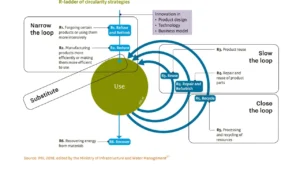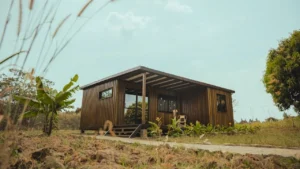 Circular Design Principles in the Built Environment
Circular Design Principles in the Built Environment
With the built environment producing 40% of global carbon emissions (11% from building materials and 29% from the building’s operations), the call to transition from linear to circular building is growing louder and louder. The world predominantly operates in a linear economy - a one way system of extracting resources, creating products for consumption and later disposing of them. This linear approach also applies to how most buildings are constructed, used and disposed of in the built environment.
Accounting for more than three billion tonnes of raw materials, the construction industry is the world’s largest consumer of raw materials. At present, building methods that use steel, brick and mortar are more popular than alternatives, despite their long construction times and high rates of pollution. They are far from sustainable and put a strain on the limited resources available, not to mention the creation of waste that is choking landfills and incinerators.
A circular economy breaks away from this linear approach by promoting the constant use of resources over a long period of time. “The key to a circular economy is closing the loop of products and raw materials, keeping them in use as intensively and as long as possible, preventing wastage and waste as much as possible.” Image 1 below illustrates the “6Rs” of sustainability in a circular economy. The more the materials are kept in circulation, the more efficiently they are used.

Image 1: R ladder of circularity strategies
These principles are easily transferable to the built environment. The goal should be to consider the entire building as a bank for construction materials that can be taken apart and reused even after the building’s life cycle has been completed. For example, building materials from one structure can be reused in the construction of another (R3 Reuse). In this way, circular design can create long term economic value and flexibility that linear designs cannot offer.
Several new initiatives are popping up using circularity strategies, including Easy Housing - a startup with a growing presence in East and West Africa employing circular and biobased construction. A biobased economy can leverage nature based solutions to create sustainable housing. Regenerative materials, like sustainably sourced timber, keep growing since they are harvested at maximum sustainable yield. This enables a sustainable forest economy where forestry companies get the resources they need to protect, maintain and expand their forest concessions or plantations.

Image 2: Prefabricated timber home in West Nile, Uganda, by Easy Housing.
Working together with the Ugandan start-up Green Home, the houses stand on foundation blocks made of recycled plastic which have proven to be just as sturdy as concrete foundation blocks. Standardised building frames are attached using screws allowing for easy rebuilding, relocation, and repurpose of materials. To avoid insulation materials that cause pollution, Easy Housing has been working with biobased insulation made of papyrus and passive design principles such as an overhang over the veranda, reflective windows and white roof sheets. The homes are kept cool during the day and warm at night without any additional energy use. Easy Homes come with a solar panel for household energy and rainwater tanks for water and energy creation for household consumption. Total lifecycle costs are thus significantly lower than traditional brick and mortar homes.
Despite the benefits, there is still some resistance to change. Changing building materials might cause a shift in supply chains and thus disrupt construction timelines. Disassembly of components from structures is perceived to be time consuming, tedious and expensive. There is a lack of expertise on using alternative building materials, thus a subsequent fear that quality will be compromised if bricks and concrete are not used.
The biggest lesson learned from introducing this circular building technology in the African market is that demonstration homes are vital to the success of alternative building concepts. Negative end-user perceptions about timber as a viable building material are rife, so a change in mindset is a tough challenge to overcome. Demonstration homes give a first hand experience of the homes and assuage safety fears surrounding the risk of fire, rain and termite damage. Additionally, end-user engagement from the design to occupancy stage provides essential feedback that can be channelled into producing a satisfactory home. Lastly, demonstration homes are a great opportunity to see the gaps in the supply chain and enforce quality control checks before construction on the final home commences.
The main advantages of circular building are waste reduction, improved resource utilisation and reduction of carbon emissions and pollution. These make for a healthier and safer environment. Additionally, it propels the achievement of most of the Sustainable Development Goals (SDGs). Every stakeholder in the built environment has a crucial part to play in the transition to circular building.
Solutions employing circularity in the built environment can help to close the housing gap in a sustainable way. Buildings are needed, especially in urban areas, and it is simply not sustainable to continue on the take-make-dispose path; effective changes need to be made. Since cities carry the lion’s share of both residential and non-residential buildings, they can play a pivotal role in implementing effective sustainability measures by transitioning from linear to circular building strategies.
Resources:
- Easy Housing Concepts
- Five Top Tips for Building a Circular Economy
- Circular Buildings: Constructing a sustainable future, de Graaf et al, 2022
- What a sustainable circular economy would look like
- Our Prosperity is in Peril
- Biobased construction: the number one solution for a sustainable world?
- Understanding barriers to a circular economy: cases from the manufacturing industry
- Barriers of circular economy in the construction industry
- Barriers and Enablers to Circular Building Design in the US: An Empirical Study, Rios et al, 2021
- How to design a building on Circular Economy principles, Cullinan Studio, June 2022
Authored by Takudzwa Madzingira